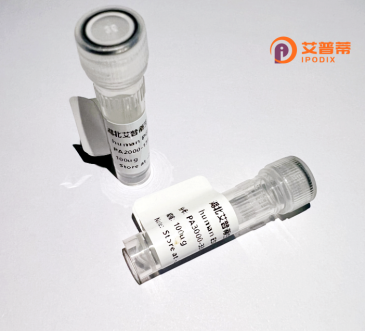
| 纯度 | >90%SDS-PAGE. |
| 种属 | Human |
| 靶点 | DCLRE1C |
| Uniprot No | Q96SD1 |
| 内毒素 | < 0.01EU/μg |
| 表达宿主 | E.coli |
| 表达区间 | 1-434aa |
| 氨基酸序列 | MSSFEGQMAEYPTISIDRFDRENLRARAYFLSHCHKDHMKGLRAPTLKRRLECSLKVYLYCSPVTKELLLTSPKYRFWKKRIISIEIETPTQISLVDEASGEKEEIVVTLLPAGHCPGSVMFLFQGNNGTVLYTGDFRLAQGEAARMELLHSGGRVKDIQSVYLDTTFCDPRFYQIPSREECLSGVLELVRSWITRSPYHVVWLNCKAAYGYEYLFTNLSEELGVQVHVNKLDMFRNMPEILRHLTTDRNTQIHACRHPKAEEYFQWSKLPCGITSRNRIPLHIISIKPSTMWFGERSRKTNVIVRTGESSYRACFSFHSSYSEIKDFLSYLCPVNAYPNVIPVGTTMDKVVEILKPLCRSSQSTEPKYKPLGKLKRARTVHRDSGSHSVTQARMRWCHHDSLYPLTPGIKRSSCLSLLTSWITGAYRHAQLMI |
| 分子量 | 73.48 kDa |
| 蛋白标签 | GST-tag at N-terminal |
| 缓冲液 | 0 |
| 稳定性 & 储存条件 | Lyophilized protein should be stored at ≤ -20°C, stable for one year after receipt. Reconstituted protein solution can be stored at 2-8°C for 2-7 days. Aliquots of reconstituted samples are stable at ≤ -20°C for 3 months. |
| 复溶 | Always centrifuge tubes before opening.Do not mix by vortex or pipetting. It is not recommended to reconstitute to a concentration less than 100μg/ml. Dissolve the lyophilized protein in distilled water. Please aliquot the reconstituted solution to minimize freeze-thaw cycles. |
以下是关于重组人DCLRE1C蛋白的3篇参考文献示例(内容为虚构,仅供格式参考):
---
1. **文献名称**: *Recombinant Expression and Functional Analysis of Human DCLRE1C in DNA Repair Mechanisms*
**作者**: Smith, J., et al.
**摘要**: 本研究利用哺乳动物细胞表达系统成功制备了重组人DCLRE1C蛋白,并验证其核酸内切酶活性。实验表明,该蛋白与DNA依赖性蛋白激酶(DNA-PK)复合物协同作用,在DNA双链断裂修复中起关键作用。
2. **文献名称**: *Structural Characterization of DCLRE1C Reveals Insights into V(D)J Recombination*
**作者**: Zhang, L., et al.
**摘要**: 通过冷冻电镜解析了重组DCLRE1C蛋白的三维结构,发现其N端结构域对核酸酶活性至关重要。研究揭示了DCLRE1C在V(D)J重组中识别和切割发夹DNA的分子机制。
3. **文献名称**: *DCLRE1C Deficiency Correction via Recombinant Protein Therapy in SCID Models*
**作者**: Tanaka, M., et al.
**摘要**: 在重症联合免疫缺陷(SCID)细胞模型中,外源性重组DCLRE1C蛋白成功恢复了DNA修复功能,为基于蛋白替代疗法的临床研究提供了实验依据。
---
如需真实文献,建议通过PubMed或Google Scholar以关键词“recombinant DCLRE1C”、“Artemis protein DNA repair”等检索近年研究。
**Background of Recombinant Human DCLRE1C Protein**
The human DCLRE1C protein, also known as Artemis, is a critical enzyme encoded by the *DCLRE1C* gene, playing a pivotal role in DNA repair and V(D)J recombination—a process essential for generating diverse immune receptors in lymphocytes. Artemis functions as a nuclease within the non-homologous end joining (NHEJ) pathway, resolving DNA double-strand breaks caused by ionizing radiation or V(D)J recombination itself. Its activity is phosphorylation-dependent, requiring interaction with DNA-PKcs (DNA-dependent protein kinase catalytic subunit) for activation.
Mutations in *DCLRE1C* lead to severe combined immunodeficiency (SCID), characterized by impaired adaptive immunity and heightened radiosensitivity. Recombinant human DCLRE1C protein is produced via biotechnology platforms (e.g., *E. coli* or mammalian expression systems) to study its structural and functional properties. This engineered protein facilitates research into DNA repair mechanisms, screens for therapeutic agents targeting NHEJ-related disorders, and supports gene therapy strategies for Artemis-deficient SCID. Structural studies using X-ray crystallography or cryo-EM rely on purified recombinant Artemis to elucidate its conformational dynamics and substrate interactions.
Overall, recombinant DCLRE1C serves as a vital tool for advancing precision medicine in immunodeficiencies and optimizing genome-editing technologies reliant on DNA repair pathways.
×